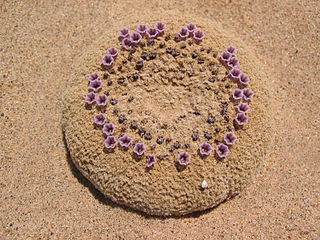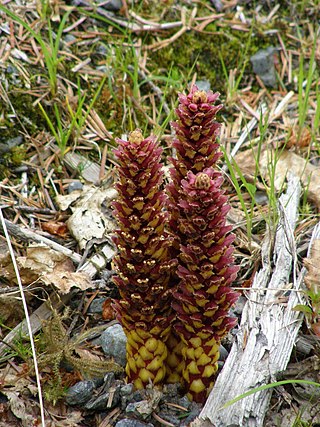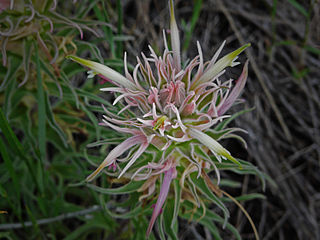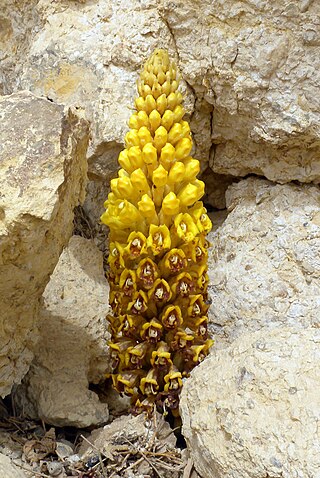
Lathraea (toothwort) is a small genus of five to seven species of flowering plants, native to temperate Europe and Asia. They are parasitic plants on the roots of other plants, and are completely lacking chlorophyll. They are classified in the family Orobanchaceae.

Rhinanthus minor, known as yellow rattle, is a herbaceous wildflower in the genus Rhinanthus in the family Orobanchaceae. It has circumpolar distribution in Europe, Russia, western Asia, and northern North America. An annual plant, yellow rattle grows up to 10–50 centimetres (3.9–19.7 in) tall, with upright stems and opposite, simple leaves. The fruit is a dry capsule, with loose, rattling seeds.

Orobanchaceae, the broomrapes, is a family of mostly parasitic plants of the order Lamiales, with about 90 genera and more than 2000 species. Many of these genera were formerly included in the family Scrophulariaceae sensu lato. With its new circumscription, Orobanchaceae forms a distinct, monophyletic family. From a phylogenetic perspective, it is defined as the largest crown clade containing Orobanche major and relatives, but neither Paulownia tomentosa nor Phryma leptostachya nor Mazus japonicus.

Pholisma sonorae, commonly known as sandfood, is a rare and unusual species of flowering plant endemic to the Sonoran Deserts to the west of Yuma, Arizona in the California Yuha, Mojave Desert and Colorado Desert, and south in the Yuma Desert, where it is known from only a few locations.

Haloxylon ammodendron, variously called the saxaul, black saxaul, also spelled sacsaoul or saksaul is a plant belonging to the family Amaranthaceae. "Saksaul" is a common Turkic word that entered Russian through Kazakh.

Pedicularis densiflora, known commonly as Indian warrior or warrior's-plume lousewort, is a plant in the family Orobanchaceae.

A parasitic plant is a plant that derives some or all of its nutritional requirements from another living plant. They make up about 1% of angiosperms and are found in almost every biome. All parasitic plants develop a specialized organ called the haustorium, which penetrates the host plant, connecting them to the host vasculature – either the xylem, phloem, or both. For example, plants like Striga or Rhinanthus connect only to the xylem, via xylem bridges (xylem-feeding). Alternately, plants like Cuscuta and some members of Orobanche connect to both the xylem and phloem of the host. This provides them with the ability to extract resources from the host. These resources can include water, nitrogen, carbon and/or sugars. Parasitic plants are classified depending on the location where the parasitic plant latches onto the host, the amount of nutrients it requires, and their photosynthetic capability. Some parasitic plants can locate their host plants by detecting volatile chemicals in the air or soil given off by host shoots or roots, respectively. About 4,500 species of parasitic plants in approximately 20 families of flowering plants are known.

Pontederia crassipes, commonly known as common water hyacinth, is an aquatic plant native to South America, naturalized throughout the world, and often invasive outside its native range. It is the sole species of the subgenus Oshunae within the genus Pontederia. Anecdotally, it is known as the "terror of Bengal" due to its invasive growth tendencies.

Cistanche deserticola is a holoparasitic member of the plant family Orobanchaceae, commonly known as desert-broomrape.

Boschniakia is a genus of parasitic plants in the family Orobanchaceae. They are known commonly as groundcones and they are native to western North America and extreme northeastern Asia. Some taxonomists consider Boschniakia to be three separate genera: Boschniakia, Kopsiopsis, and Xylanche. When the genus is split, only a single species remains: Boschniakia rossica, the northern groundcone.

Bellardia trixago is a species of flowering plant in the family Orobanchaceae. The only member of the monotypic genus Bellardia, it is known as trixago bartsia or Mediterranean lineseed. This plant is native to the Mediterranean Basin, but it is known in other places with similar climates, such as California and parts of Chile, where it is an introduced species and noxious weed.
A xerophyte is a species of plant that has adaptations to survive in an environment with little liquid water. Examples of xerophytes include cacti, pineapple and some gymnosperm plants. The morphology and physiology of xerophytes are adapted to conserve water during dry periods. Some species called resurrection plants can survive long periods of extreme dryness or desiccation of their tissues, during which their metabolic activity may effectively shut down. Plants with such morphological and physiological adaptations are said to be xeromorphic. Xerophytes such as cacti are capable of withstanding extended periods of dry conditions as they have deep-spreading roots and capacity to store water. Their waxy, thorny leaves prevent loss of moisture.

Haloxylon is a genus of shrubs or small trees, belonging to the plant family Amaranthaceae. Haloxylon and its species are known by the common name saxaul. "Saksaul" is a common Turkic word that entered Russian through Kazakh.

Orobanche rapum-genistae, the greater broomrape, is a plant species in the genus Orobanche. It is a parasitic plant, native to Europe, growing on the roots of plants in the bean family, usually common broom or European gorse.

Castilleja sessiliflora is a species of flowering plant in the family Orobanchaceae known by the common names downy Indian paintbrush and downy paintedcup. It is native to the Great Plains of North America from southern Canada, through the central United States, to northern Mexico. It occurs as far west as the eastern slopes of the Rocky Mountains.

Cistanche tubulosa is a desert holoparasitic plant species in the genus Cistanche. It lacks chlorophyll and obtains nutrients and water from the host plants whose roots it parasitizes.

Aureolaria pedicularia, the fernleaf yellow false foxglove, fern-leaved false foxglove, or fernleaf false foxglove, is a parasitic plant of the family Orobanchaceae. Aureolaria pedicularia is native to parts of the eastern US, the Midwest, and adjacent Canada. This plant is known for its distinct leaf shape and overall plant size. The common names for Aureolaria pedicularia come from its fern-like leaves.

Cymbaria is a genus of flowering plants in the broomrape family Orobanchaceae, native to Ukraine, Russia, Kazakhstan, Siberia, the Altai, Mongolia, northern China and Manchuria. They are hemiparasites of other plants, obtaining nutrients through haustoria which attach to the roots of the hosts, and doing some photosynthesis on their own.

Cistanche phelypaea, also spelled Cistanche phelipaea, is a species of plant in the family Orobanchaceae. It has a wide range of distribution from the Arabian Peninsula and the Syrian Desert in the east, through the Sahara, Cyprus, Crete and the southwest of the Iberian Peninsula, to Macaronesia in the west.

A psammophyte is a plant that grows in sandy and often unstable soils. Psammophytes are commonly found growing on beaches, deserts, and sand dunes. Because they thrive in these challenging or inhospitable habitats, psammophytes are considered extremophiles, and are further classified as a type of psammophile.



















